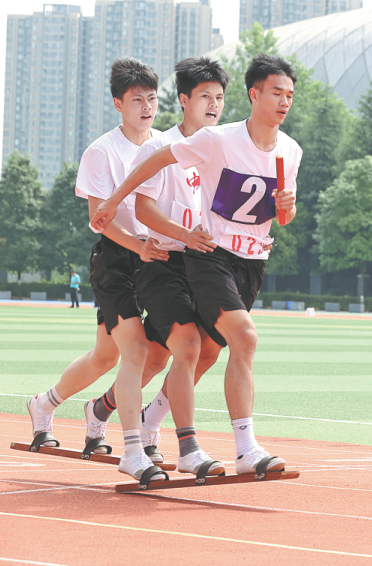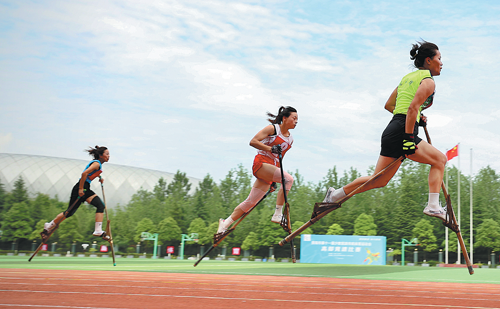Traditional games start

From left: The crossbow originated in the Chu state during the Warring States Period. The people at that time used it as a tool for living and hunting, and it was widely used in the army in the later periods. Crossbow shooting has gradually become a popular national sport; red and blue balls are laid on the field during a cuqiu game, each with a different number, and divided into two camps according to the color; the referee checks the result in a crossbow shooting match. [Photo provided to China Daily]
The 11th Guiyang Traditional Ethnic Sports Meeting kicked off on Tuesday at Guiyang Healthcare Vocational University in Southwest China's Guizhou province. The event is divided into competition and performance sections. A total of 13 delegations compete in seven competitions, including wrestling, crossbow, spinning top, ball games, shoe racing, high-foot racing and aerobics. The performance sports are categorized into eight major categories and 32 smaller ones.
For the performance routine, the contestants of each delegation wear different costumes and perform, in turn, on stage. The unique Miao drum stick relay, the lively lion dance and the joyful Bouyei ethnic fighter shuttlecock are the highlights among a series of shows that amaze the crowd with their expertise.
Every act and move of the contestants demonstrates a variety of ethnic styles. Yajia, a tug-of-war, attracts a quieter crowd. During the competition, two athletes wrap the same cloth around their necks, lie on both ends of the field, climb in opposite directions, and they win by pulling over into the designated area. During the competition, the players are under immense physical stress with the veins on their necks and temples bulging, and their faces contorted.

Shoe racing is a game in which three athletes wear wooden slippers made of two wooden boards to compete. [Photo provided to China Daily]
"Boom! Slap!" The crossbow arrows are let loose from the taut strings, as attendees follow their flight to the target. A gym is hosting the event and sounds seem to ricochet off the walls. The crossbow, of course, is an improved version of the bow and arrow.
The crossbow is composed of a crossbow piece, a bed and a string. When using it, the crossbow string made of jute must be pulled into the inlay, the arrow is placed in the groove, and the trigger is pulled before shooting. The competition is divided into different subitems according to the standing position, kneeling position and the gender of the contestant.
The spinning top event also requires supreme physical attributes. Spinning the top, seeing it hurtle then pulling the whip rope back requires a certain dexterity. The player scores when their object hits the opponent's spinning top and pushes it out of bounds. Victory can also be claimed by one top spinning longer than the opponent's.

From left: An intense rope skipping competition; in a spinning top game, the player scores when their object hits the opponent's spinning top and pushes it out of bounds. Victory can also be claimed by one top spinning longer than the opponent's; in yajia, a tug-of-war, two athletes wrap the same cloth around their necks, lie on both ends of the field, climb in opposite directions, and win by pulling over into the designated area. [Photo provided to China Daily]
Cuqiu (kickball) requires just a small area and is suitable for all ages. The origin of the name is borrowed from the ancient game cuju, a competitive game equivalent to modern-day football that involves kicking a ball through an opening into a net, but the rules are completely different. Red and blue balls are laid on the field, each with a different number, and divided into two camps according to the color. Players use the soles of their feet to massage the ball, then they attempt to hit the opponent's ball.
High-foot racing and shoe racing boast distinct ethnic features. High-foot racing is also called "riding a bamboo horse". Different from ordinary track and field running, the athlete's feet are on pedals, and in their hands they hold bamboo poles during running. They have to run along steps.
Shoe racing is a competition in which three athletes wear wooden slippers made of two wooden boards to compete. The main draw of the game is that the pace has to be consistent among each player.

High-foot racing is also called "riding a bamboo horse". Different from ordinary track and field running, the athlete's feet are on pedals, and in their hands they hold bamboo poles during running. They have to run along steps. [Photo provided to China Daily]
Guiyang, capital of Guizhou province, has jurisdiction over six districts, three counties and one city center. With its 18 ethnic townships and a population of 5.99 million, Guiyang has 55 out of China's 56 ethnic groups. The sole exception is the Yugur ethnic group.
The most commonly seen ethnic groups in Guiyang are Miao, Bouyei, Tujia, Yi, Dong, Gelao, Bai, Hui, Manchu, Zhuang and Sui.
The Guiyang Traditional Ethnic Sports Meeting is held every four years. The games follow the tenet of "equality, unity, hard work and progress", aiming to fully demonstrate the colorful ethnic sportsmanship in Guiyang.
The event also aims to cultivate outstanding sports talents of all ethnic groups, carry forward their excellent sports culture, promote national unity and progress, and strive to write a new chapter of "strong sports capital" in the new era.
Presented by China Daily.
黔ICP备05001922号
All Rights Reserved.
Presented by China Daily.
黔ICP备05001922号



